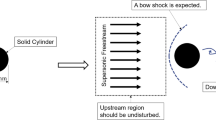Abstract
Most numerical schemes for solving high-speed compressible flow problems exhibit an instability that usually occurs inside the numerical shock structure in low-dissipative shock-capturing finite volume methods. In examining several test cases, the flux-difference splitting and the AUSM family of schemes cannot satisfy the robustness requirement, which manifests as the carbuncle phenomenon on two-dimensional triangular grids. This paper presents an accurate and robust AUSM-family scheme (\(\hbox {AUSMDV}^+\) scheme) that is verified against shock-induced anomalies on two-dimensional triangular grids. The linearized discrete analysis of an odd–even decoupling problem is applied to investigate the perturbation damping mechanism of these schemes. The corresponding recursive equations show that the \(\hbox {AUSMDV}^+\) scheme is less sensitive to these anomalies than are other schemes in the AUSM family. Finally, the presented scheme is extended to achieve second-order solution accuracy. Its robustness and efficiency are then evaluated on both structured and unstructured triangular grids. The \(\hbox {AUSMDV}^+\) scheme yields a physically meaningful solution for all test cases without introducing an additional shock fix technique.













Similar content being viewed by others
References
Peery, K.M., Imlay, S.T.: Blunt-body flow simulations. 24th Joint Propulsion Conference, Boston, MA, AIAA Paper 1988-2904 (1988). https://doi.org/10.2514/6.1988-2904
Roe, P.L.: Approximate Riemann solvers, parameter vectors, and difference schemes. J. Comput. Phys. 43(2), 357–372 (1981). https://doi.org/10.1006/jcph.1997.5705
Phongthanapanich, S., Dechaumphai, P.: Healing of shock instability for Roe’s flux-difference splitting scheme on triangular meshes. Int. J. Numer. Methods Fluids 59(5), 559–575 (2009). https://doi.org/10.1002/fld.1834
Ramalho, M.V.C., Azevedo, J.H.A., Azevedo, J.L.F.: Further investigation into the origin of the carbuncle phenomenon in aerodynamic simulations. AIAA Paper 2011-1184 (2011). https://doi.org/10.2514/6.2011-1184
Phongthanapanich, S.: A parameter-free AUSM-based scheme for healing carbuncle phenomenon. J. Braz. Soc. Mech. Sci. Eng. 38(3), 691–701 (2016). https://doi.org/10.1007/s40430-015-0368-7
Robinet, JCh., Gressier, J., Casalis, G., Moschetta, J.M.: Shock wave instability and the carbuncle phenomenon: same intrinsic origin? J. Fluid Mech. 417, 237–263 (2000). https://doi.org/10.1017/S0022112000001129
Quirk, J.J.: A contribution to the great Riemann solver debate. Int. J. Numer. Methods Fluids 18(6), 555–574 (1994). https://doi.org/10.1002/fld.1650180603
Dumbser, M., Moschetta, J.M., Gressier, J.: A matrix stability analysis of the carbuncle phenomenon. J. Comput. Phys. 197(2), 647–670 (2004). https://doi.org/10.1016/j.jcp.2003.12.013
Wada, Y., Liou, M.S.: An accurate and robust flux splitting scheme for shock and contact discontinuities. SIAM J. Sci. Comput. 18(3), 633–657 (1997). https://doi.org/10.1137/S1064827595287626
Elling, V.: The carbuncle phenomenon is incurable. Acta Math. Sci. 29B(6), 1647–1656 (2009). https://doi.org/10.1016/S0252-9602(10)60007-0
Sanders, R., Morano, E., Druguet, M.C.: Multidimensional dissipation for upwind schemes: stability and applications to gas dynamics. J. Comput. Phys. 145(2), 511–537 (1998). https://doi.org/10.1006/jcph.1998.6047
Pandolfi, M., D’Ambrosio, D.: Numerical instabilities in upwind methods: analysis and cures for the “Carbuncle” phenomenon. J. Comput. Phys. 166(2), 271–301 (2001). https://doi.org/10.1006/jcph.2000.6652
Phongthanapanich, S., Dechaumphai, P.: Modified multidimensional dissipation scheme on unstructured meshes for high-speed compressible flow analysis. Int. J. Comput. Fluid Dyn. 18(8), 631–640 (2004). https://doi.org/10.1080/10618560412331297641
Phongthanapanich, S.: A modified multidimensional dissipation technique for AUSM+ on triangular grids. Int. J. Comput. Fluid Dyn. 29(1), 1–11 (2015). https://doi.org/10.1080/10618562.2015.1010525
Phongthanapanich, S.: Multidimensional dissipation technique for AUSM scheme on triangular grids. Trans. Can. Soc. Mech. Eng. 39(2), 1–15 (2015). https://doi.org/10.1139/tcsme-2015-0022
Phongthanapanich, S.: Healing of the carbuncle phenomenon for AUSMDV scheme on triangular grids. Int. J. Nonlinear Sci. Numer. 17(1), 15–28 (2016). https://doi.org/10.1515/ijnsns-2015-0008
Toro, E.F., Spruce, M., Speares, W.: Restoration of the contact surface in the HLL-Riemann solver. Shock Waves 4(1), 25–34 (1994). https://doi.org/10.1007/BF01414629
Shen, Z., Yan, W., Yuan, G.: A robust HLLC-type Riemann solver for strong shock. J. Comput. Phys. 309, 185–206 (2016). https://doi.org/10.1016/j.jcp.2016.01.001
Schmidtmann, B., Winters, A.R.: Hybrid entropy stable HLL-type Riemann solvers for hyperbolic conservation laws. J. Comput. Phys. 330, 566–570 (2017). https://doi.org/10.1016/j.jcp.2016.10.034
Simon, S., Mandal, J.C.: A simple cure for numerical shock instability in the HLLC Riemann solver. J. Comput. Phys. 378, 477–496 (2019). https://doi.org/10.1016/j.jcp.2018.11.022
Kim, K.H., Lee, J.H., Rho, O.H.: An improvement of AUSM schemes by introducing the pressure-based weight functions. Comput. Fluids 27, 311–346 (1998). https://doi.org/10.1016/S0045-7930(97)00069-8
Kim, K.H., Kim, C., Rho, O.H.: Methods for the accurate computations of hypersonic flows I. \(\text{ AUSMPW }^+\) scheme. J. Comput. Phys. 174(1), 38–80 (2001). https://doi.org/10.1006/jcph.2001.6873
Liou, M.S.: A Sequel to AUSM: AUSM\(^+\). J. Comput. Phys. 129(2), 364–382 (1996). https://doi.org/10.1006/jcph.1996.0256
Kitamura, K., Shima, E.: Towards shock-stable and accurate hypersonic heating computations: a new pressure flux for AUSM-family schemes. J. Comput. Phys. 245, 62–83 (2013). https://doi.org/10.1016/j.jcp.2013.02.046
Edwards, J.R.: A low-diffusion flux-splitting scheme for Navier–Stokes calculations. Comput. Fluids 26(6), 635–659 (1997). https://doi.org/10.1016/S0045-7930(97)00014-5
Zha, G.C., Shen, Y., Wang, B.: An improved low diffusion E-CUSP upwind scheme. Comput. Fluids 48(1), 214–220 (2011). https://doi.org/10.1016/j.compfluid.2011.03.012
Venkatakrishnan, V.: Convergence to steady state solutions of the Euler equations on unstructured grids with limiters. J. Comput. Phys. 118(1), 120–130 (1995). https://doi.org/10.1006/jcph.1995.1084
Shu, C.W., Osher, S.: Efficient implementation of essentially non-oscillatory shock-capturing schemes. J. Comput. Phys. 77(2), 439–471 (1988). https://doi.org/10.1016/0021-9991(88)90177-5
Sod, G.A.: A survey of several finite difference methods for systems of nonlinear hyperbolic conservation laws. J. Comput. Phys. 27(1), 1–31 (1978). https://doi.org/10.1016/0021-9991(78)90023-2
Woodward, P., Colella, P.: The numerical simulation of two-dimensional fluid flow with strong shocks. J. Comput. Phys. 54(1), 115–173 (1984). https://doi.org/10.1016/0021-9991(84)90142-6
Acknowledgements
The author is pleased to acknowledge the College of Industrial Technology, King Mongkut’s University of Technology North Bangkok, Bangkok, Thailand, for funding this research work (Grant No. Res-CIT0225/2018).
Author information
Authors and Affiliations
Corresponding author
Additional information
Communicated by C.-H. Chang.
Publisher's Note
Springer Nature remains neutral with regard to jurisdictional claims in published maps and institutional affiliations.
Rights and permissions
About this article
Cite this article
Phongthanapanich, S. An accurate and robust AUSM-family scheme on two-dimensional triangular grids. Shock Waves 29, 755–768 (2019). https://doi.org/10.1007/s00193-019-00892-5
Received:
Revised:
Accepted:
Published:
Issue Date:
DOI: https://doi.org/10.1007/s00193-019-00892-5




